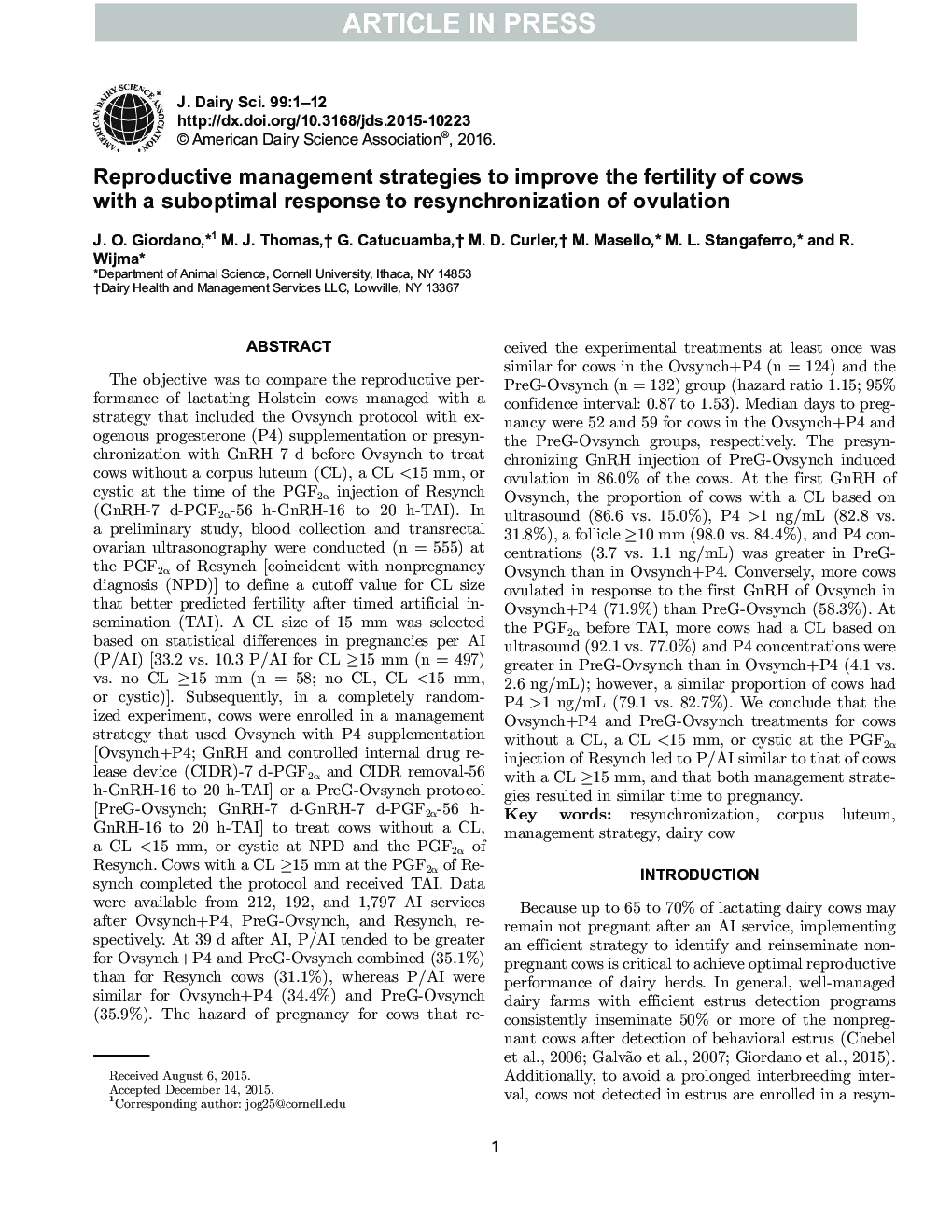| کد مقاله | کد نشریه | سال انتشار | مقاله انگلیسی | نسخه تمام متن |
|---|---|---|---|---|
| 10973112 | 1108010 | 2016 | 12 صفحه PDF | دانلود رایگان |
عنوان انگلیسی مقاله ISI
Reproductive management strategies to improve the fertility of cows with a suboptimal response to resynchronization of ovulation
دانلود مقاله + سفارش ترجمه
دانلود مقاله ISI انگلیسی
رایگان برای ایرانیان
کلمات کلیدی
موضوعات مرتبط
علوم زیستی و بیوفناوری
علوم کشاورزی و بیولوژیک
علوم دامی و جانورشناسی
پیش نمایش صفحه اول مقاله

چکیده انگلیسی
The objective was to compare the reproductive performance of lactating Holstein cows managed with a strategy that included the Ovsynch protocol with exogenous progesterone (P4) supplementation or presynchronization with GnRH 7 d before Ovsynch to treat cows without a corpus luteum (CL), a CL <15 mm, or cystic at the time of the PGF2α injection of Resynch (GnRH-7 d-PGF2α-56 h-GnRH-16 to 20 h-TAI). In a preliminary study, blood collection and transrectal ovarian ultrasonography were conducted (n = 555) at the PGF2α of Resynch [coincident with nonpregnancy diagnosis (NPD)] to define a cutoff value for CL size that better predicted fertility after timed artificial insemination (TAI). A CL size of 15 mm was selected based on statistical differences in pregnancies per AI (P/AI) [33.2 vs. 10.3 P/AI for CL â¥15 mm (n = 497) vs. no CL â¥15 mm (n = 58; no CL, CL <15 mm, or cystic)]. Subsequently, in a completely randomized experiment, cows were enrolled in a management strategy that used Ovsynch with P4 supplementation [Ovsynch+P4; GnRH and controlled internal drug release device (CIDR)-7 d-PGF2α and CIDR removal-56 h-GnRH-16 to 20 h-TAI] or a PreG-Ovsynch protocol [PreG-Ovsynch; GnRH-7 d-GnRH-7 d-PGF2α-56 h-GnRH-16 to 20 h-TAI] to treat cows without a CL, a CL <15 mm, or cystic at NPD and the PGF2α of Resynch. Cows with a CL â¥15 mm at the PGF2α of Resynch completed the protocol and received TAI. Data were available from 212, 192, and 1,797 AI services after Ovsynch+P4, PreG-Ovsynch, and Resynch, respectively. At 39 d after AI, P/AI tended to be greater for Ovsynch+P4 and PreG-Ovsynch combined (35.1%) than for Resynch cows (31.1%), whereas P/AI were similar for Ovsynch+P4 (34.4%) and PreG-Ovsynch (35.9%). The hazard of pregnancy for cows that received the experimental treatments at least once was similar for cows in the Ovsynch+P4 (n = 124) and the PreG-Ovsynch (n = 132) group (hazard ratio 1.15; 95% confidence interval: 0.87 to 1.53). Median days to pregnancy were 52 and 59 for cows in the Ovsynch+P4 and the PreG-Ovsynch groups, respectively. The presynchronizing GnRH injection of PreG-Ovsynch induced ovulation in 86.0% of the cows. At the first GnRH of Ovsynch, the proportion of cows with a CL based on ultrasound (86.6 vs. 15.0%), P4 >1 ng/mL (82.8 vs. 31.8%), a follicle â¥10 mm (98.0 vs. 84.4%), and P4 concentrations (3.7 vs. 1.1 ng/mL) was greater in PreG-Ovsynch than in Ovsynch+P4. Conversely, more cows ovulated in response to the first GnRH of Ovsynch in Ovsynch+P4 (71.9%) than PreG-Ovsynch (58.3%). At the PGF2α before TAI, more cows had a CL based on ultrasound (92.1 vs. 77.0%) and P4 concentrations were greater in PreG-Ovsynch than in Ovsynch+P4 (4.1 vs. 2.6 ng/mL); however, a similar proportion of cows had P4 >1 ng/mL (79.1 vs. 82.7%). We conclude that the Ovsynch+P4 and PreG-Ovsynch treatments for cows without a CL, a CL <15 mm, or cystic at the PGF2α injection of Resynch led to P/AI similar to that of cows with a CL â¥15 mm, and that both management strategies resulted in similar time to pregnancy.
ناشر
Database: Elsevier - ScienceDirect (ساینس دایرکت)
Journal: Journal of Dairy Science - Volume 99, Issue 4, April 2016, Pages 2967-2978
Journal: Journal of Dairy Science - Volume 99, Issue 4, April 2016, Pages 2967-2978
نویسندگان
J.O. Giordano, M.J. Thomas, G. Catucuamba, M.D. Curler, M. Masello, M.L. Stangaferro, R. Wijma,